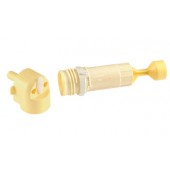Follow-up to our post on breastshield sizing: The In and Out of Breastshield Sizing …
Question from a pumping mom:
Hello,
Wondering if you have any suggestions for a problem I have. I recently bought a Medela Harmony manual pump, but the breast shield that came with it was too big. I ordered the smallest size (21mm) and it still seems too big. My areola gets pulled into the shaft and is too uncomfortable to pump. My nipples are probably only about 8mm in diameter… maybe 10 at the most. Is it possible/advisable to use nipple shields with the pump, and do you think this would work?
Thanks,
Janette
Reply from Lactation Care:
Hi Janette,
Thank you for your email. I’m sorry to hear that you are having such an uncomfortable time pumping with the harmony pump. Nipples measuring 8-10 mm in diameter are a bit smaller than average but certainly within the normal range. The problem is not your nipples! The problem lies with the limitations of the tool being utilized for the purpose of milk expression.
You may benefit from having an IBCLC lactation consultant observe you pumping so as to make the most targeted suggestions for your situation. Depending on your location, you could use zipmilk.org or ilca.org for searchable databases of IBCLCs in your area based on your zip code. If you are in the Boston area, we would be an available resource for you. It’s always most helpful to us to actually see pumping in action to make the most helpful suggestions.
Not having the benefit of seeing you pump, some suggestions I might make are:
- Try a different pump, one with an adjustable pressure setting. The pressure on the Harmony is fixed and quite high when used in the expression mode. Some women with smaller nipples have more success pumping at a lower pressure setting. A better quality electric pump would have adjustable pressure. You could hand pump and adjust the pressure if utilizing the piston and cylinder assembly for a Lactina or EnDeare. The photo below shows the Lactina piston and cylinder.
- Consider learning the art of hand expression. Most manual pumps are suitable for just occasional pumping. You may find it more comfortable and effective to hand express your milk. You can find a great resource for learning the hand expression technique from Jane Morton, IBCLC on the Stanford University website. Be warned, it’s a video, close up and detailed. You may not want to view it while traveling on a crowded city bus 😉
- Some moms find silicone breast shields to be more comfortable. You may want to try that as another option. Medela has discontinued their silicone shield. Other manufacturers, like Ameda still make them. Be warned, an Ameda silicone shield would not be compatible with a Medela pump, Ameda’s inserts are 25mm at the base. You’d have to purchase an Ameda pump just to test drive that theory.
- If you are game to experiment a bit, you could try to retain your areola by modifying a 16 mm silicone nipple shield by cutting off the nipple tip, about halfway down the shaft and applying it to your nipples prior to pumping with the 21 mm flange. This might offer just enough resistance to hold your areola back and give your nipple 16 mm of wiggle room. Use a very sharp blade or straight razor to make the cut as you do not want any ragged edges. Be warned, this is totally me thinking outside the box and untested by us! I don’t know if it would work at all, but I’d be curious to know if you try it. Be warned too, that any mom using a nipple shield for any period of time runs the risk of potentially lessening the stimulation to the breast and should take steps to ensure adequate drainage of the breast and maintenance of supply. It may also be a lot of fuss if you’re just looking for occasional use. Hand expression is by far the most parsimonious solution. Hand expression provides the added benefit of resulting in “cleaner” milk that is higher in fat and protein than milk expressed by a vacuum pump. Something to consider…
I hope this info has been helpful! Good luck! Consider getting some hands on help from a qualified lactation expert if you continue to struggle with this issue.
Best,
Andrea Jorgensen, IBCLC

